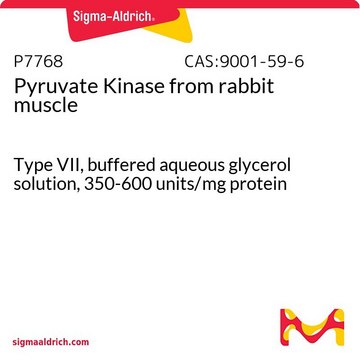P4390
Polynucleotide Kinase from T4-infected Escherichia coli
10 units/μL, buffered aqueous glycerol solution
Faça loginpara ver os preços organizacionais e de contrato
About This Item
Número CAS:
Número MDL:
Código UNSPSC:
12352204
NACRES:
NA.53
Produtos recomendados
grau
Molecular Biology
for molecular biology
Formulário
buffered aqueous glycerol solution
peso molecular
33 kDa
concentração
10 units/μL
atividade externa
Endonuclease and exonuclease, none detected
Condições de expedição
wet ice
temperatura de armazenamento
−20°C
Procurando produtos similares? Visita Guia de comparação de produtos
Aplicação
Suitable for:
- Sequencing or nucleic acid tagging (DNA and RNA) by 5′-end labeling
- 5′ phosphorylation of oligonucleotides
- Removal of 3′-phosphate groups from phosphorylpolynucleotides
Componentes
T4 Polynucleotide Kinase is supplied in a solution of 50% glycerol (v/v), 20 mM Tris-HCl (pH 7.5), 25 mM KCl, 2mM DTT, 0.1 mM EDTA, and 0.1 μM ATP.
Princípio
Polynucleotide kinase catalyses a "forward reaction" transfer of the γ-phosphate of ATP to the 5′ hydroxyl terminus of single- and double-stranded nucleic acids (DNA and RNA) and 3′-nucleoside monophosphates. In exchange reactions containing ADP, the enzyme will catalyze the exchange of 5′-terminal phosphate groups and ATP. The 3′-phosphatase activity enables the enzyme to remove 3′-phosphoryl groups from phosphorylpolynucleotides.
1. Forward reaction: Transfer of the labeled γ-phosphate from [γ-32P]-ATP to the free 5′-hydroxyl group of the substrate.
5′-HO-DNA + [γ-32P]-ATP → 5′-32PO-DNA + ADP.
Substrates that do not have a free 5′-hydroxyl require prior dephosphorylation by alkaline phosphatase.
2. Exchange reaction: First, the terminal 5′-phosphate is transferred from the substrate to ADP present in the reaction mixture. Then, the labeled γ-phosphate from [γ-32P]-ATP is transferred to the free hydroxyl group of the substrate.
5′-PO-DNA + ADP → 5′-HO-DNA + ATP
5′-HO-DNA + [γ-32P]-ATP → 5′-32PO-DNA + ADP
1. Forward reaction: Transfer of the labeled γ-phosphate from [γ-32P]-ATP to the free 5′-hydroxyl group of the substrate.
5′-HO-DNA + [γ-32P]-ATP → 5′-32PO-DNA + ADP.
Substrates that do not have a free 5′-hydroxyl require prior dephosphorylation by alkaline phosphatase.
2. Exchange reaction: First, the terminal 5′-phosphate is transferred from the substrate to ADP present in the reaction mixture. Then, the labeled γ-phosphate from [γ-32P]-ATP is transferred to the free hydroxyl group of the substrate.
5′-PO-DNA + ADP → 5′-HO-DNA + ATP
5′-HO-DNA + [γ-32P]-ATP → 5′-32PO-DNA + ADP
Definição da unidade
One unit catalyzes the transfer of one nanomole of 32P to the 5′-end of micrococcal nuclease-treated DNA in 30 min. at 37 °C. Transfer is detected as incorporation into acid-insoluble material.
Nota de análise
Activity is determined in a reaction mixture containing 40 mM Tris-HCl (pH 7.5), with 10 mM MgCl2, 5 mM dithiothreitol, 0.5 mM 5′-OH polynucleotide ends, and mM [γ-32P]-ATP.
produto relacionado
Nº do produto
Descrição
Preços
Palavra indicadora
Danger
Frases de perigo
Declarações de precaução
Classificações de perigo
Resp. Sens. 1
Código de classe de armazenamento
10 - Combustible liquids
Classe de risco de água (WGK)
WGK 3
Ponto de fulgor (°F)
Not applicable
Ponto de fulgor (°C)
Not applicable
Equipamento de proteção individual
Eyeshields, Gloves, multi-purpose combination respirator cartridge (US)
Escolha uma das versões mais recentes:
Já possui este produto?
Encontre a documentação dos produtos que você adquiriu recentemente na biblioteca de documentos.
Priscilla Braglia et al.
EMBO reports, 11(10), 758-764 (2010-09-04)
Transcription termination by RNA polymerase I in Saccharomyces cerevisiae is mediated by a 'torpedo' mechanism: co-transcriptional RNA cleavage by Rnt1 at the ribosomal DNA 3'-region generates a 5'-end that is recognized by the 5'-3' exonuclease Rat1; this degrades the downstream
V Cameron et al.
Biochemistry, 16(23), 5120-5126 (1977-11-15)
The purification of T4 polynucleotide kinase results in the copurification of an activity which will specifically remove the 3'-terminal phosphate from a variety of deoxyribonucleotides and ribonucleotides in the absence of ATP. This phosphatase activity requires magnesium, has a pH
Saranya Siribal et al.
Molecular and biochemical parasitology, 180(1), 1-7 (2011-08-09)
Polynucleotide kinase/phosphatase (PNKP) is a bifunctional enzyme that can phosphorylate the 5'-OH termini and dephosphorylate the 3'-phosphate termini of DNA. It is a DNA repair enzyme involved in the processing of strand break termini, which permits subsequent repair proteins to
Takao Mori et al.
Molecular biology of the cell, 21(21), 3722-3734 (2010-09-17)
The unfolded protein response (UPR) is an essential signal transduction to cope with protein-folding stress in the endoplasmic reticulum. In the yeast UPR, the unconventional splicing of HAC1 mRNA is a key step. Translation of HAC1 pre-mRNA (HAC1(u) mRNA) is
Wenhe Wu et al.
Chemical communications (Cambridge, England), 47(4), 1201-1203 (2010-11-26)
We designed a single-fluorophore-tagged hairpin-structured nano-beacon probe by using a superquencher, graphene oxide (GO), based on which a new method for the analysis of DNA phosphorylation detection was developed.
Nossa equipe de cientistas tem experiência em todas as áreas de pesquisa, incluindo Life Sciences, ciência de materiais, síntese química, cromatografia, química analítica e muitas outras.
Entre em contato com a assistência técnica







